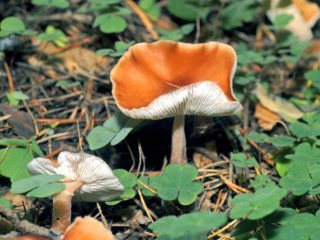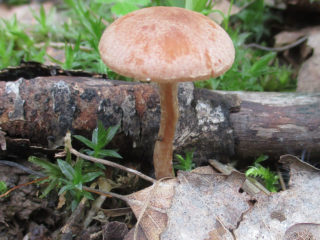Content
Kalocera sticky, or deer horns, is a conditionally edible mushroom of low quality. Belongs to the Dikramicaceae family and grows on dry, rotten woody substrate. In cooking it is used as a decoration for cold and meat dishes, but only after heat treatment. This specimen has inedible doubles, therefore, in order not to harm your body, you need to study the external description, view photos and videos.
What do sticky caloceras look like?
This representative of the forest kingdom can be recognized by the unusual shape of the fruiting body and its bright color. The mushroom forms a small, weakly branched bush in the form of a coral, up to 8 cm high. The mucous surface has an orange or dark lemon tint. The pulp is elastic, gelatinous, without taste or aroma.Reproduction occurs by microscopic spores that are located throughout the fruiting body.
Where do calocera adhesive grow?
The forest dweller prefers to grow on rotten coniferous substrate, individually or in small families. It begins to bear fruit from July to October and is distributed throughout Russia.
Is it possible to eat sticky caloceras?
Due to the lack of taste and aroma, as well as because of the rubbery, gelatinous pulp, this specimen has not found wide use in cooking. It is collected very rarely for food purposes; the harvested crop can be boiled, fried and dried. And thanks to its gelatinous pulp, many housewives add it to jellied meat until it hardens. But most mushroom pickers prefer not to collect it, but only to photograph it.
Despite its dubious taste, the mushroom is used in folk medicine in many countries.
How to distinguish sticky caloceras
This forest dweller, like any representative of the mushroom kingdom, has doubles:
- Horn-shaped – the mushroom is inedible, but also non-toxic. It can be found in all Russian forests; it prefers moist coniferous, less often deciduous, tree litter. It begins to bear fruit from late summer until the first frost. It can be recognized by its bright orange color and club-shaped or horn-shaped shape. Since the pulp is tasteless and odorless, it is used extremely rarely in cooking.
- Dacrimyces vanishing - a small drop-shaped or spherical mushroom of bright orange color. The fruit body is red or yellow, gelatinous, odorless and tasteless. Found from June until the first frost, prefers rotten coniferous wood.This species is considered inedible and can cause mild food poisoning if eaten.
Conclusion
Kalocera adhesive is a conditionally edible species common in coniferous forests. It begins to bear fruit from late summer until the first frost. This representative has no nutritional value, but due to its bright color and great resemblance to corals, this species is better to admire than to eat.












